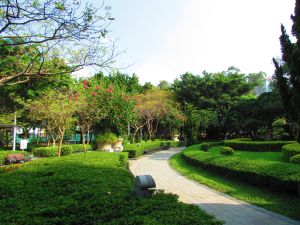|
Hong Kong is a dense and compact city, where people and trees have become more interrelated. Over the years, the Government has been striving to enrich and enhance the city’s landscape and strengthen our tree management. To create a more liveable and sustainable cityscape, we need to integrate the concepts and principles of urban forestry into our urban design and development projects so as to promote greening in a more holistic manner. We also need to formulate, plan and monitor landscape works and tree management measures in a pragmatic way. As such, the Development Bureau (DEVB) established the Urban Forestry Advisory Panel (UFAP) in January 2017 to replace the former Expert Panel on Tree Management (EPTM) to assist us in performing our work and to carry out consultation in a more extensive and effective manner.
Urban forestry is not confined to tree management. It covers a wide range of work. The Greening, Landscape and Tree Management Section of the DEVB is formulating urban forestry strategies with a view to setting up a strategic framework to manage our urban landscape assets in a holistic and sustainable manner. In future, apart from providing expert advice on the management policies and practical operation regarding the Old and Valuable Trees, stonewall trees and trees identified as of special significance (including whether such trees should be removed), the UFAP will also advise us on the policies and management strategies in relation to urban arboriculture, urban ecology and urban landscapes.
In addition, the UFAP will provide professional advice on applied research and development within a practical and measureable framework, and on the promotion of positive capacity building in urban forestry related industries and trades. We can see from the above that the work of the UFAP is more comprehensive and diversified than that of the former EPTM.
Make reference to overseas experience
As overseas countries and the Mainland have started early in developing urban forestry management and accumulated years of experience and research findings, the views of their experts and professionals are well worth our consideration. Members of the UFAP, comprise local and overseas experts with demonstrated practical experience including urban ecologists/restoration ecologists, urban forestry managers, urban arborists and forest pathologists. They possess rich knowledge and experience and are well-recognised in their respective fields. I believe that they can broaden our horizons and enrich our knowledge in urban forestry management, which help us formulate appropriate policies. When these experts and practitioners visit Hong Kong for meetings, we will make use of the opportunity to organise talks, so that they can exchange knowledge and experience sharing with local experts and practitioners, hence raising the standards for the profession and trade.
Given the large number of trees growing on slopes and stonewall trees in Hong Kong at present, we have, in addition to urban forestry experts, professionals and stakeholders, invited geotechnical engineers to join the UFAP to provide professional advice on structural safety.
Continue to listen to different views
I would like to take this opportunity to express my heartfelt gratitude to members of the EPTM, the term of which expired at the end of 2016. Since its establishment in 2011, the EPTM had provided professional advice on various aspects of our tree management work, including both management and practices, and made significant contributions. I want to stress that when we formulate urban forestry policies and measures in future, apart from consulting the UFAP, we will also listen carefully to views from the trade, as well as professionals, academics and stakeholders of the related fields in Hong Kong. We will do our best and introduce international good practices while addressing the local conditions.
The success of the Government’s policies and measures regarding urban forestry hinges on public understanding and support. While we will continue with our work earnestly, members of the public and stakeholders are welcome to actively take part in our work and offer valuable opinions. Let us make Hong Kong a more sustainable and safe city together.
|
|
|
|
| The Government has been closely monitoring the growth of big trees lining Nathan Road in Tsim Sha Tsui. |
|
|
|
Planting trees along the pavements in various districts helps create a green environment. Picture shows Tai Po Tai Wo Road.
|
 |
|
Urban forestry covers not just tree management but also landscape architecture. Picture shows the Victoria Park, which provides a balance of soft landscape and leisure spaces for public enjoyment.
|
|